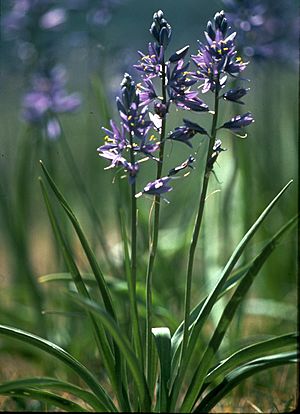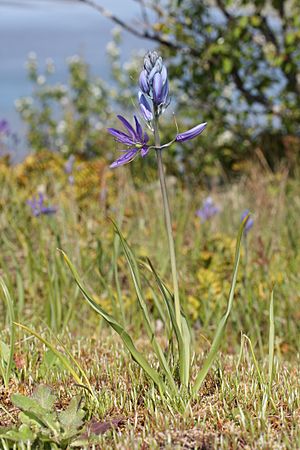Common camas facts for kids
Quick facts for kids Common Camas |
|
|---|---|
 |
|
| Camassia quamash (Pursh) Greene | |
| Scientific classification |
Camassia quamash, often called camas or common camas, is a beautiful plant that comes back every year. It's a type of herb that grows naturally in western North America. You can find it in large areas of southern Canada and the northwestern United States. This includes places like British Columbia, Alberta, California, Washington, Montana, and Wyoming.
Contents
What is Camas Like?
How it Grows
Camas is a perennial plant, which means it lives for more than two years. It's a type of herb with leaves that grow from a special underground bulb. These leaves form a circle close to the ground, like a basal rosette.
Leaves, Stems, and Flowers
The stems of the camas plant can grow to be about 30 to 90 centimeters (12 to 35 inches) tall. Its leaves grow from the base of the plant and look a lot like grass.
In late spring or early summer, usually around May or June, the camas plant shows off its pretty flowers. These flowers can be light blue to a deep blue color. They grow in a cluster at the top of the stem, forming a shape called a raceme. Each flower looks like a star and has six petals.
Naming the Camas Plant
Different Kinds of Camas
There are actually eight different types, or subspecies, of Camassia quamash. They all look a bit different but are part of the same plant family.
Where the Name Comes From
The name Camassia comes from the Nez Perce Indian people. It means "sweet." The Nez Perce and other tribes in the Pacific Northwest used the plant's bulb as an important food source. They called the bulb Qém'es.
The Lewis and Clark Expedition (1804–1806) also relied on these bulbs for food. Women from tribes like the Nez Perce, Cree, and Blackfoot would gather the bulbs. They would then cook them by roasting them in a pit or boiling them.
Where Camas Grows
Camas used to grow in huge fields, but many of these areas have become smaller. This is because of modern buildings and farms. However, you can still find many camas fields and wet areas today.
In the past, when more settlers moved into the Great Basin area, they let their cattle and pigs eat the camas plants. This meant less food for the native tribes. This caused problems between Native Americans and the new settlers. Some wars, like the Bannock War and Nez Perce War, started partly because settlers plowed up the camas fields. These fields were very important for the tribes to find food.
Growing Camas in Gardens
Camas bulbs grow well in gardens and can spread naturally. They like soil that drains water well and has a lot of rich, dark material called humus. You can grow camas in lightly shaded forest areas or on rocky spots. They also do well in open fields or prairies. Sometimes, you can even find them growing next to streams and rivers.
If you want to grow more camas, you can divide the bulbs in the fall after the leaves have dried up. The plant also spreads by its seeds, not by underground runners.
How People Use Camas
Camas is not just a plant you can eat; it's also grown for its beauty. In the wild, large groups of camas can make an entire field look blue-violet!
Camas as Food
The bulbs of Camassia plants are good to eat and full of nutrients when they are roasted or boiled. But it's very important not to confuse them with a dangerous plant called meadow death-camas. This plant has white flowers and is very poisonous. Its bulbs look very similar to camas bulbs, and they grow in the same areas. So, you must be very careful!
Camas has been a major food source for many native peoples in the western United States and Canada. After the flowers have faded in the autumn, the bulbs are gathered. They are then cooked in a pit or boiled. Boiling them can even make a sweet syrup.
A camas bulb cooked in a pit tastes a bit like a baked sweet potato, but it's sweeter. It also has more natural fibers because of something called inulin. Eating too many undercooked bulbs can cause a lot of gas, though! The bulbs can also be dried and ground into flour. This flour can be used for baking or to make sauces thicker.
Many Native American tribes, including the Nez Perce, Cree, Coast Salish, Lummi, and Blackfoot tribes, ate camas bulbs. These bulbs also helped the Lewis and Clark Expedition explorers survive their journey.
Camas bulbs (and a type of bread called bannock made from them) are listed in the Ark of Taste. This is a list of special foods that are important to protect.
Images for kids
-
Camassia quamash subsp. maxima, Skagit County, Washington
-
Camas meadow near Bovill, Idaho
-
Indian Camas (Camassia quamash) Bald Hill Park, Corvallis, Oregon










